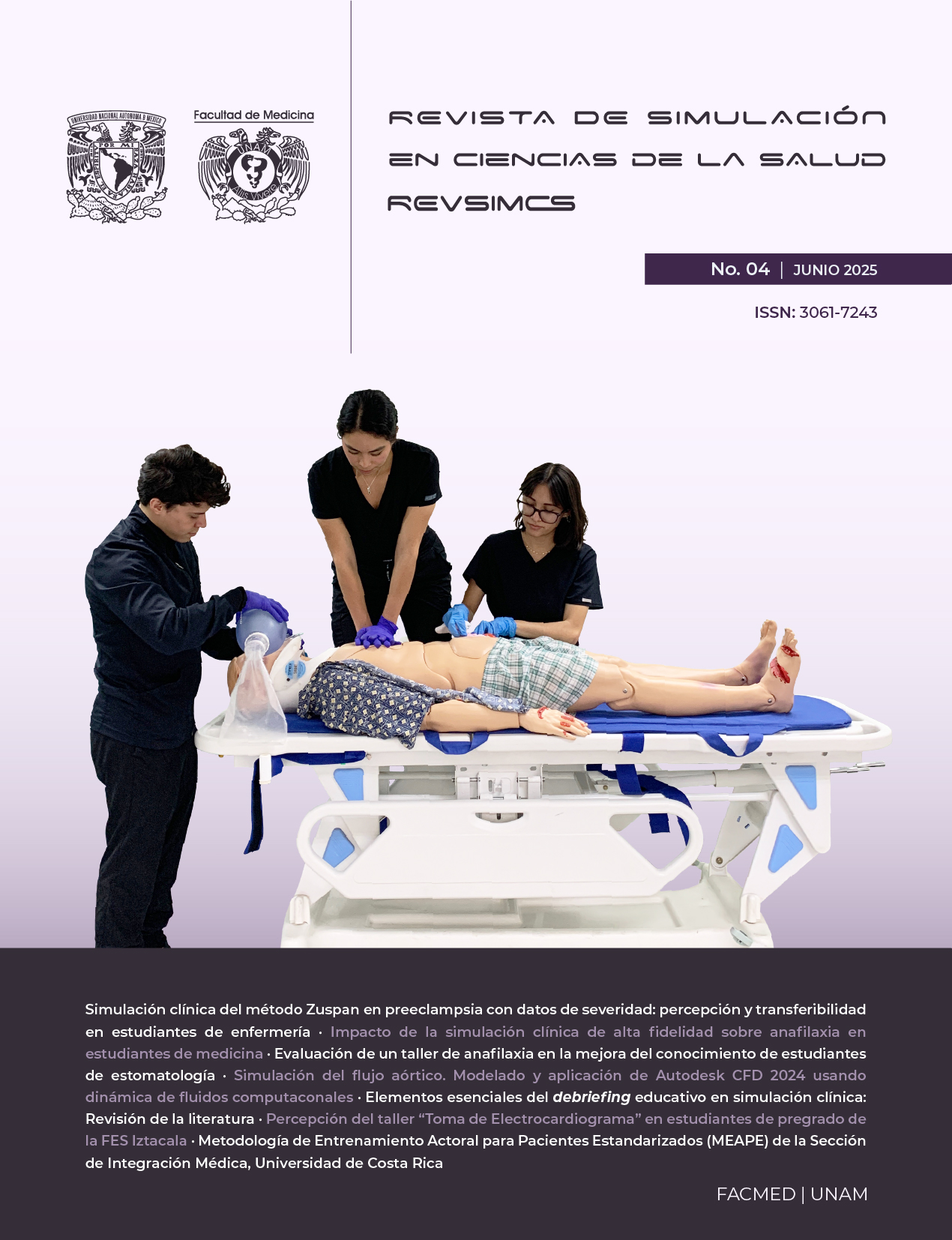Metodología de Entrenamiento Actoral para Pacientes Estandarizados (MEAPE) de la Sección de Integración Médica, Universidad de Costa Rica
DOI:
https://doi.org/10.22201/fm.30617243e.2025.4.112Palabras clave:
Simulación de Paciente, Ciencias en las Artes, Educación Médica, Investigación InterdisciplinariaResumen
La presente propuesta metodológica surge de una investigación-acción desarrollada por el equipo de Artes Dramáticas de la Sección de Integración Médica (SIM) de la Universidad de Costa Rica, con el objetivo de documentar un modelo integral de entrenamiento actoral para Pacientes Estandarizados (PE) en el contexto de la simulación clínica. La metodología MEAPE se fundamenta en principios del realismo escénico, particularmente en el Método de las Acciones Físicas de Stanislavski y el trabajo momento a momento de Meisner, adaptados al entorno educativo médico. Se estructura en cinco fases: análisis del guion clínico, construcción del personaje, ensayo, simulación del escenario y retroalimentación (debriefing), que incorpora, además, una etapa de autoevaluación crítica. El modelo enfatiza la creación de personajes tridimensionales con coherencia biopsicosocial, lo que contribuye a una experiencia de aprendizaje más enriquecedora, realista y empática para el estudiantado. La colaboración entre profesionales de medicina y artes dramáticas permite alinear objetivos pedagógicos y actorales, que permiten la optimización de la fidelidad escénica y la eficacia formativa.
Referencias
A Benedetti, J. (2005). Stanislavski y el trabajo del actor (5.ª ed.), Alba Editorial.
Cleland, J. A., Abe, K., & Rethans, J. J. (2009). The use of simulated patients in medical education: AMEE Guide No 42. Medical Teacher, 31(6), 477–486. https://doi.org/10.1080/01421590903002821
Dawson, R. M., Lawrence, K., Gibbs, S., Davis, V., Mele, C., & Murillo, C. (2021). “I Felt The Connection”: A Qualitative Exploration of Standardized Patients’ Experiences in a Delivering Bad News Scenario. Clinical Simulation in Nursing, 55, 52–58. https://doi.org/10.1016/j.ecns.2021.04.012
Gaba, D. M. (2004). The future vision of simulation in health care. Quality and Safety in Health Care, 13(suppl 1), i2–i10. https://doi.org/10.1136/qhc.13.suppl_1.i2
Gliva-McConvey, G. (2020). Standardized patient methodology in health professions education. In K. T. Bosse (Ed.), Clinical simulation: Education, operations, and engineering (pp.183–200). Elsevier.
INACSL Standards Committee. (2021). Healthcare Simulation Standards of Best Practice™: Prebriefing: Preparation and briefing. Clinical Simulation in Nursing, 58, 9–13. https://doi.org/10.1016/j.ecns.2021.08.008
Kol, E., Ince, S., Işik, R. D., Ilaslan, E., & Mamakli, S. (2021). The effect of using standardized patients in the Simulated Hospital Environment on first-year nursing students psychomotor skills learning. Nurse Education Today, 107, 105147. https://doi.org/10.1016/j.nedt.2021.105147
Kucukkelepce, G. E., Dinc, L., & Elcin, M. (2021). Views of nursing students on using standardized patient and in-class case analysis in ethics education. Nurse Education Today, 107, 105155. https://doi.org/10.1016/j.nedt.2021.105155
Lewis, K., Bohnert, C., Gammon, W., Hölzer, H., Lyman, L., Smith, C., Thompson, T., Wallace, A., & Gliva-McConvey, G. (2017). The Association of Standardized Patient Educators (ASPE) Standards of Best Practice (SOBP). Advances in Simulation, 2(10). https://doi.org/10.1186/s41077-017-0043-4
May, W., Park, J. H., & Lee, J. P. (2009). A ten-year review of the literature on the use of standardized patients in teaching and learning: 1996–2005. Medical Teacher, 31(6), 487–492. https://doi.org/10.1080/01421590802530898
Meisner, S., & Longwell, D. (1987). Sanford Meisner on acting. Vintage Books.
Moore, P. M., Rivera Mercado, S., Grez Artigues, M., & Lawrie, T. A. (2018). Communication skills training for healthcare professionals working with people who have cancer. Cochrane Database of Systematic Reviews, (7). https://doi.org/10.1002/14651858.CD003751.pub4
Motola, I., Devine, L. A., Chung, H. S., Sullivan, J. E., & Issenberg, S. B. (2013). Simulation in healthcare education: A best evidence practical guide. AMEE Guide No. 82. Medical Teacher, 35(10), e1511–e1530. https://doi.org/10.3109/0142159X.2013.818632
Nestel, D., & Tierney, T. (2007). Role-play for medical students learning about communication: Guidelines for maximising benefits. BMC Medical Education, 7, 3. https://doi.org/10.1186/1472-6920-7-3
Reinhardt, A. C., León, T. G., DeBlieck, C., & Amatya, A. (2019). Using simulations to advance clinical reasoning. Applied Nursing Research, 47, 63-70. https://doi.org/10.1016/j.apnr.2019.05.005
Rudolph, J. W., Simon, R., Dufresne, R. L., & Raemer, D. B. (2006). There’s no such thing as “nonjudgmental” debriefing: A theory and method for debriefing with good judgment. Simulation in Healthcare, 1(1), 49–55. https://doi.org/10.1097/01266021-200600110-00006
Society for Simulation in Healthcare. (2020). Definition of healthcare simulation. https://ssih.org/sites/default/files/2025-03/Healthcare-Simulation-Dictionary-3.pdf
Stanislavski, K. (2013). An Actor Prepares (E. R. Hapgood, Trans.). Bloomsbury Publishing.
Talente, G., Haist, S. A., & Wilson, J. F. (2003). A model for setting performance standards for standardized patient examinations. Evaluation & the Health Professions, 26(4), 427–446. https://doi.org/10.1177/0163278703258105
Yudkowsky, R., Park, Y. S., & Downing, S. M. (2022). Assessment in health professions education (2nd ed.). Routledge. https://www.taylorfrancis.com/books/edit/10.4324/9781138054394/assessment-health-professions-education-rachel-yudkowsky-yoon-soo-park-steven-downing



